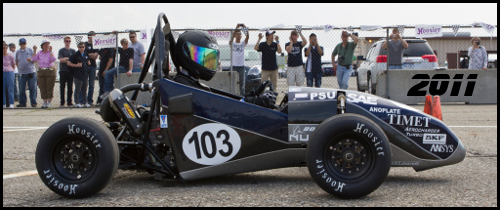
Increased Power
The centerpiece of Penn State Racing’s 2011 formula car lies in its powertrain. This year’s powertrain built upon the lessons learned from the 2010 car’s naturally aspirated Honda CRF450x. The team retained the familiar Honda engine and custom fuel injection system, but that powerplant is now mated to a Aerocharger variable-vane turbo. Also, the engine is now controlled by a more advanced Motec M400 ECU, featuring additional input and output channels and much higher data logging rates. These changes have resulted in improvements in power and drivability in a more consistent, reliable package.
Retuned Suspension
Suspension design is one of the most vital aspects of a successful Formula SAE car. Because of this fact, much effort was put into addressing any shortcomings of the 2010 suspension design. The result of that effort is a completely revamped suspension for 2011. The traditional front anti-roll bar has been replaced with an innovative blade based design, while new dampers allow more suspension travel and improved motion ratios. Lastly, as always, the suspension is machined in-house from titanium to optimize weight savings. These changes have resulted in a car that is both faster and more predictable for drivers under all conditions.
Keeping the Driver Informed
The connection between driver and car is always of vital importance in a racing environment. In addition to intuitive controls and predictable dynamics, the 2011 car features one of the most advanced driver information systems in FSAE. While the 2010 car only featured a basic LCD dash display, the 2011 model features a touchscreen OLED display that can be configured to show anything from typical gauge layouts to track maps. In addition to providing this information to the driver, all data that is accessible through the dash can also be wirelessly logged onto a laptop in the pit. The data recorded ranges from engine parameters provided by the new M400 ECU to detailed suspension data recorded by a variety of car-mounted sensors. All of this data results in the ability to precisely tune the car to the driver’s exact specifications.
A Legacy of Light Weight
Lightweight engineering has always been one of the cornerstones of Penn State Racing’s designs. In the words of Colin Chapman, founder of Lotus, “Adding power makes you faster on the straights. Subtracting weight makes you faster everywhere.” For the 2011 season, the team placed great emphasis on maintaining a lightweight car despite the addition of forced induction and an advanced data acquisition system. As a result, the team fielded the lightest forced induction car in the competition.
